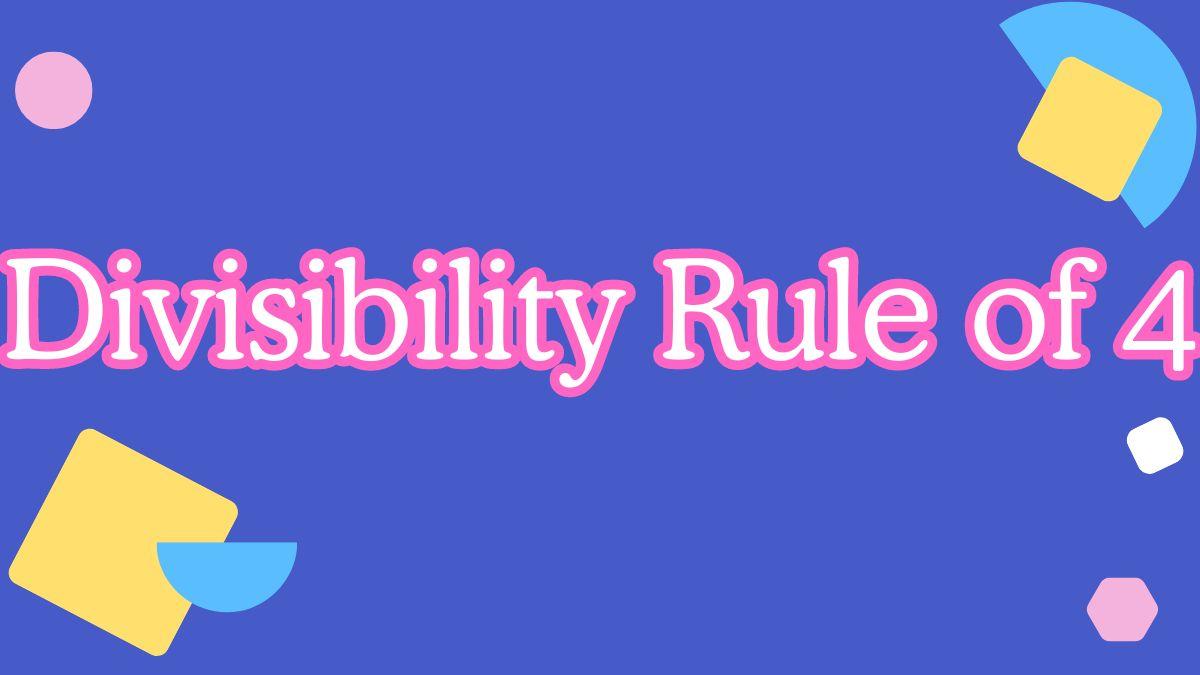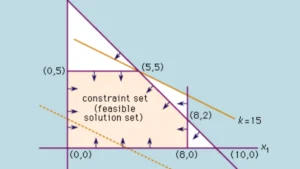Table of Contents
The divisibility rule of 4 is a useful math trick that makes it easier to see if a number is divisible by 4 evenly. This rule is especially handy in a range of mathematical scenarios, from doing math in your head to tackling problems in number theory. A number is said to be divisible by 4, if on dividing that particular number by 4, the quotient comes to be a whole number and the remainder comes 0. Check complete details regarding the 4 divisibility rule here.
Divisibility Rule of 4
4 is a special number in mathematics due to being the smallest composite number. That is why questions are frequently asked on the concept of divisibility rule of 4. If the final two digits of a number are zeroes or make a number divisible by 4, then that number is divisible by 4, according to the rule of divisibility for 4. It is also referred to as the 4 divisibility rule.
The rule of divisibility for 4 assists in determining if a number is divisible by 4 without actually dividing it. The initial four integers that can be divided by 4 are 0, 4, 8, 12, and 16. Every number mentioned is a multiple of 4, and each of these multiples is divisible by 4 without any remainder.
Divisibility by 4
Division plays a crucial role in mathematics, though it can be challenging with larger numbers such as 23900. Yet, within the realm of mathematics, there exists a remedy to this issue in the shape of divisibility rules that can ascertain if a number is specifically divisible by another number.
To tackle this problem, we will examine the rules for determining if a number is divisible by 4 and how to ascertain if a number is considered perfectly divisible by four. Furthermore, as divisibility holds significance in quantitative aptitude. The divisibility by 4 is quite simple to understand as it is common for all numbers.
How to Know a Number is Divisible by 4?
We can easily find out if a number is divisible by 4 by using its divisibility rule. As per the rule for divisibility by 4, a whole number can be divided by 4 if it meets one of two conditions:
- If the final two digits of the specified number are zeroes. This indicates that the number includes zeros in the tens place and ones in the ones place. In the case of 300, the final two digits being 00 mean that 300 can be divided by 4.
- If the number’s last two digits create a number that divides evenly by 4. In 316, as an example, the final two digits combine to create the number 16, which can be divided by 4. As a result, 316 can be evenly divided by 4.
Divisibility Rule of 4 Examples
The numbers: 500, 644, 864, 428, 136, 900 are divisible by 4 because their last two digits are either zeroes or multiple of fours. Like in 500 and 900, the last two digits are zeroes, hence they are divisible by 4. In another number like 428, the last two digits 28, is divisible by 4, so the number 428 is also divisible by 4. Some of the numbers that are not divisible by 4 are: 453, 277, 326, 422, 975, 350, etc.
Divisibility Rule of 4 for Large Numbers
According to the divisibility rule of 4 for large numbers, a large number is likewise divisible by 4 if it ends with two zeros or if the final two digits of the number make an accurate division by 4. As a result, we may determine whether or not a huge number is divisible by four by looking up the final two digits and using the divisibility rule of four.
Solved Examples on Divisibility Rule of 4
Candidates should practice the solved examples provided below on the divisibility test of 4 to make this concept strong.
Example 1: Is number 148936 divisible by 4?
Solution: The given number = 148936
Using the 4 divisibility test, we will examine the last two digits
The last two digits are 36 (non zeroes) but 36 is divisible by 4
Hence, the number 148936 is divisible by 4.
Example 2: Check if 766 is divisible by 4
Solution: The last two digits of the given number = 66
66 is neither 0s and are also not divisible by 4
Hence, the given number is not divisible by 4
Example 3: How many two digits numbers are divisible by 4
Solution: The Numbers divisible by 4 follow the series: 12, 16, 20, … 96.
This forms an AP with a common difference of 4
The smallest two digits number divided by 4 = 12
The largest two digit number divisible by 4 = 96
Using the AP formula, T = a + (n-1) d
where, T = last term, d = common difference, n = number of terms, a = first term
Here, T = 96, a = 12, d = 4
We have to find the value of n
On substituting the given values in the standard equation, we get
96 = 12 + (n-1)4
84 = 4n – 4
88 = 4n
or n = 22
Hence, there are 22 two digit numbers divisible by 4
Example 4: Check the number 238900 for divisibility of 4
Solution: The last two digits of the given number 238900 are zeroes.
Hence, the number 238900 is divisible by 4
Example 5: Is 840 divisible by 4
Solution: The last two digits of the given number is 40, which is divisible by 4. Hence the given number will also be divisible by 4.




 Greater Than and Less Than, Equal to Sig...
Greater Than and Less Than, Equal to Sig...
 Class 12 Mathematics Linear Programming ...
Class 12 Mathematics Linear Programming ...
 NCERT Solutions Maths Chapter 4 Determin...
NCERT Solutions Maths Chapter 4 Determin...









